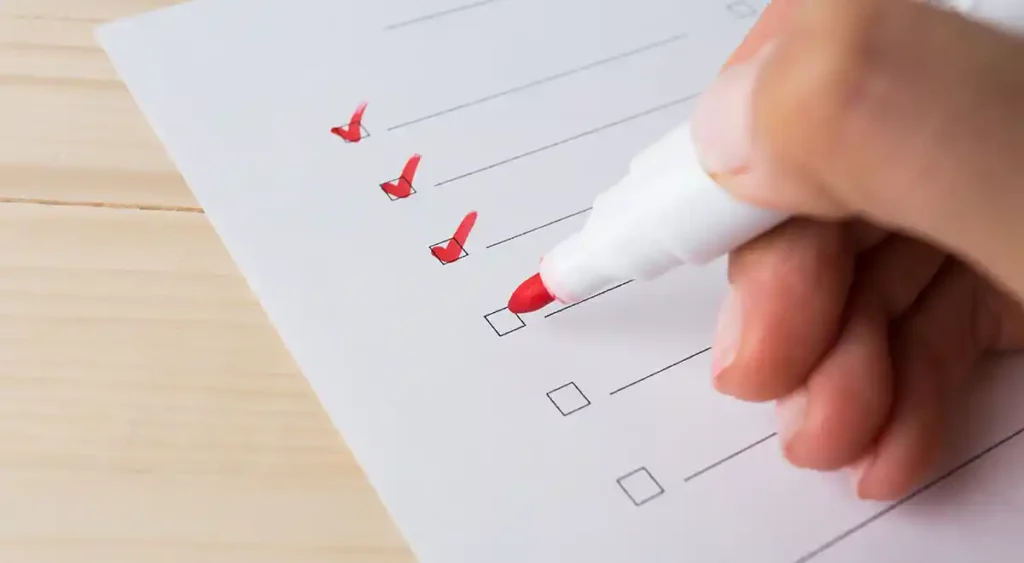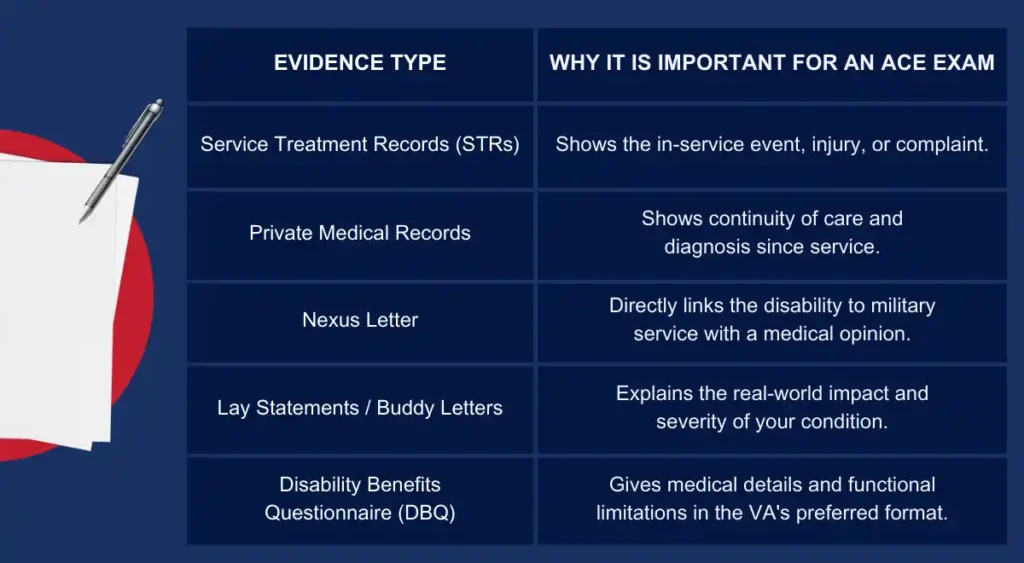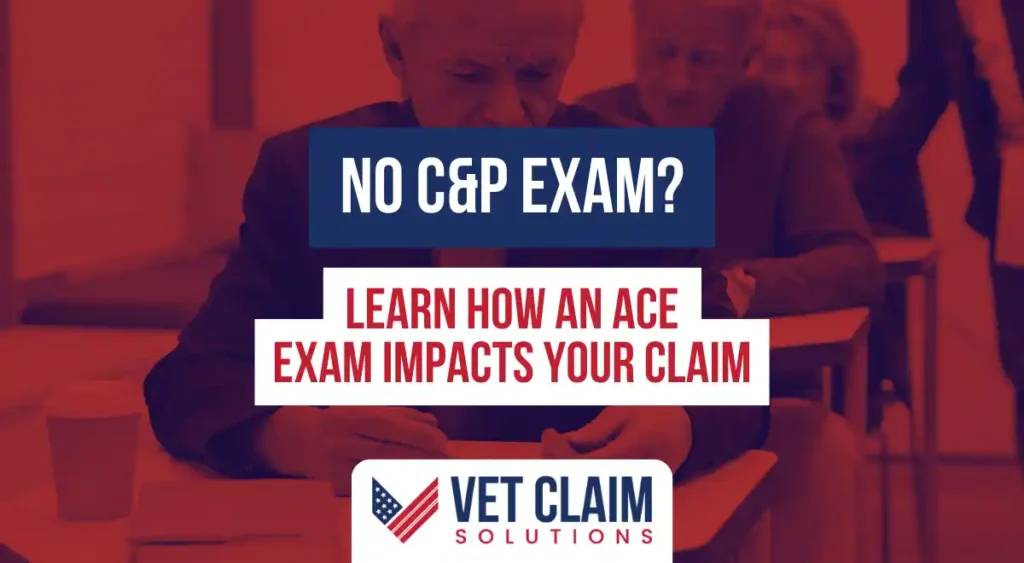You’ve been waiting for that letter or phone call to schedule your Compensation and Pension (C&P) exam. But weeks turn into months, and you hear nothing. Then, you check your VA status and see a note about something called an ACE exam, and you start to worry.
If you’re thinking, “No C&P exam? You may get an ACE exam instead. Learn what it means, how it works and why it’s still crucial for your claim,” you are not alone. This is becoming more common for veterans submitting a VA claim, but it doesn’t mean your claim is in trouble.
An ACE exam can sometimes be a good sign that your claim is moving forward efficiently. We’ll explain what this exam is and how it impacts your journey toward getting the VA benefits you deserve. Understanding this part of the claims process helps you feel more in control.

What exactly is an ACE Exam?
ACE stands for Acceptable Clinical Evidence. Think of it as a C&P exam done entirely based on the records in your claim file. Instead of you traveling to a VA medical center or a contractor’s office, the examiner reviews your documentation from their own location.
An ACE exam is a thorough review of your existing medical and non-medical evidence. A VA examiner or a contract provider sifts through everything you and the VA have gathered. This includes service treatment records, private doctor notes, medical opinions, and any other documents you provided to support your claim for a service-connected disability.
The entire exam process happens without you being present, which is why the quality of your submitted paperwork is so important. Your file must contain enough acceptable clinical evidence for the examiner to make a medical assessment. This behind-the-scenes review is a critical step toward a claim decision.
Why Did the VA Schedule an ACE Exam for Me?
You might be wondering why you received an ACE exam instead of a traditional one. There isn’t just one reason for this. The Department of Veterans Affairs uses this process for a few specific situations to improve the efficiency of the claims process.
Most of the time, it boils down to having sufficient evidence in your file. But let’s look at the most common reasons this happens. Knowing why can help you better understand the status of your claim for disability compensation.
You Already Have Enough Medical Evidence
This is often the main reason, and it can be a very good thing. It could mean you submitted such a well-prepared VA disability claim that the VA has all the clinical evidence it needs. The evidence is so clear they can make a decision without needing to see you in person.
If your private doctor filled out a detailed Disability Benefits Questionnaire (DBQ), that alone might be enough acceptable clinical evidence. A solid nexus letter from a qualified medical professional that establishes service connection also helps tremendously. When your claim file leaves no questions unanswered, an in-person exam is not always needed.

Your Claim is for an Increased Rating
ACE exams are also common for claims for increase. You’re already service-connected for a condition, but you believe it has gotten worse. You are filing a claim asking for a higher disability rating to reflect your increased level of disability.
In this scenario, the VA just needs to review new medical evidence to justify the increase. They want proof that your symptoms have worsened over time or are impacting you more severely. Your recent treatment records from a local VA medical center or private physician might show this progression clearly, making an in-person exam unnecessary.
The VA is Working Through a Backlog
The VA has a large number of disability claims to process at any given time. The ACE process is faster than scheduling, performing, and processing an in-person claim exam. It helps the VA work through cases more quickly and issue decisions sooner.
Using tools like the ACE process helps reduce the waiting time for many veterans. A VA claim expert will tell you that efficiency is a major goal for the Veterans Affairs system. So, getting an ACE exam might mean you get a decision on your claim much sooner than if you had an original appointment scheduled weeks or months out.
The ACE Exam Process and What It Means for You
Understanding the ACE process takes away the fear of the unknown. An ACE exam might feel strange because you are not actively participating in a face-to-face meeting. However, your role is central to the exam’s success because of the evidence you provided.
The ACE Process Step-by-Step
The ACE process is fairly straightforward from the veteran’s perspective. First, you might get a notice from the VA or one of their contractors, like VES, QTC, or LHI. This notice will tell you that a review of your records has been scheduled instead of an in-person exam.
Next, an examiner is assigned to your case, either from the VA health care system or a contract provider. This person is a licensed medical professional who will thoroughly review every piece of evidence in your file. They review medical records, lay statements, and anything else relevant to the conditions you’ve claimed.
In most cases, the examiner will not contact you at all. However, there is a small chance they might call you if they have a quick question to clarify something from your records. For this reason, it’s a good idea to answer calls from unknown numbers while your claim is in this stage.
Is an ACE Exam Good or Bad for My Claim?
It’s natural to wonder if this development is good or bad news. The truth is, an ACE exam itself is neutral; the exam result is what matters. The decision to use the ACE process is neither a positive nor a negative sign for your claim’s ultimate outcome.
The best way to view it is as a reflection of the strength of your claim file. If your evidence is strong, complete, and clear, an ACE exam can be great news. It means your claim is moving forward and likely faster than it would have otherwise, bringing you closer to the VA pay you deserve.
The main potential downside is that you don’t get to speak to the examiner in person. You can’t explain in your own words how your condition affects you daily, which can be a bad experience if your records don’t tell the whole story. This makes the written statements you submit, like personal and buddy letters, even more powerful and important.
How to Prepare for an ACE Exam (Even Though You Don’t Attend)
How do you prepare for an exam you don’t actually go to? The preparation happens long before you even file your VA disability claim. It is all about building a solid foundation of evidence from the very beginning.
Thinking this way shifts your focus from being a passive waiter to an active participant. You aren’t just waiting for the VA to make a decision. You are building your case with expert-level VA claim evidence from day one to support your right to disability benefits.
Submit a Fully Developed Claim
A Fully Developed Claim (FDC) is one where you submit all relevant evidence at the start of the process. You’re telling the VA, “Here is everything you need to make a decision.” This program can significantly speed up your claim’s processing time because it reduces the VA’s need to gather records.
This means gathering all your service treatment records and any private medical records from before, during, and after your service. You want to give the examiner a complete history of your condition from its onset. Don’t assume the VA will find everything for you; being proactive is a huge advantage.
The Power of a Strong Nexus Letter
A nexus letter is a medical opinion from a qualified professional that serves as a piece of clinical evidence. It connects your disability to a specific event, injury, or illness during your military service. This is one of the most vital pieces of evidence you can have, especially for establishing a service connection.
During an ACE exam, a well-written nexus letter speaks for you and provides clear medical opinions. It explains the medical link that the examiner is looking for in a language the VA understands. A letter stating your condition is “at least as likely as not” due to your service is the standard the VA uses.

Don’t Forget Lay Statements (Buddy Letters)
Your medical records show a diagnosis and treatment history. They often fail to show how that diagnosis impacts your daily life and ability to function. That’s where lay statements from a spouse, family member, friend, or fellow service member come in.
These are written statements describing how your condition affects your ability to work, socialize, and perform everyday tasks. For mental health claims or chronic pain conditions, these personal stories are critical. They paint a picture of your life that medical records alone cannot convey.
Think about what the doctor can’t see during a short appointment. Does your back pain prevent you from playing with your kids? Do you avoid crowds because of anxiety? These are the powerful details that buddy letters can provide directly to the examiner reviewing your file.
Use a Disability Benefits Questionnaire (DBQ)
A DBQ is a downloadable form created by the VA for a specific condition. It contains checkboxes and sections for a doctor to fill out, covering symptoms, severity, and functional impact. You can take this form to your own doctor and have them complete it based on their evaluation.
Submitting a DBQ from a doctor who knows you and your condition is incredibly effective. It presents crucial medical information in the exact format the VA rater wants to see. The VA’s website provides access to these forms, and they can be a cornerstone of your acceptable clinical evidence ace strategy.

What to Do After You Learn You’re Having an ACE Exam
So, you’ve gotten the news that your file is under review for an ACE exam. What can you do right now? There are a few small things that can still help your claim.
First, check your claim status regularly using the VA’s online status tool. If you’ve had any recent doctor appointments or received new medical test results, upload those records immediately. There might still be time for the examiner to see them and include them in their review.
Also, as mentioned before, be prepared for a potential phone call from the exam provider or examiner. They may want to clarify something simple, like the start date of a symptom or a medication you are taking. A two-minute phone call could make a huge difference, so don’t have a missed exam on your record, even if it is just a phone call.
Most importantly, try not to stress about the ACE exam process. It is a normal part of the system for many veterans. It’s a sign that your claim is actively being worked on and moving forward.
What if I Get a Denial After an ACE Exam?
Receiving a denial after any exam can be discouraging, but it is not the end of the road. If the exam result is unfavorable, your first step is to carefully read the VA’s decision letter. The letter will explain why the claim was denied and what evidence was considered.
Often, a denial after an ACE exam comes down to insufficient evidence. The examiner may have felt your file lacked the necessary clinical evidence to support your claim. This gives you a clear path forward: strengthen your evidence.
You can file a Supplemental Claim and submit new and relevant evidence, such as a stronger nexus letter or a DBQ from a specialist. You could also request a Higher-Level Review if you believe there was an error in how the VA handled your claim. The key is to analyze the reason for the denial and address it directly with more information.

Conclusion
An ACE exam might feel like a surprise, but it’s just a different tool the VA uses to evaluate disability claims. It isn’t inherently better or worse than a traditional C&P exam. Its effectiveness for your claim depends entirely on the quality and completeness of the evidence you’ve provided.
This process highlights just how important it is to be proactive when filing for VA disability benefits. Building a strong claim from the beginning is your best strategy. By submitting all your medical records, a powerful nexus letter, a completed benefits questionnaire, and compelling lay statements, you give the examiner everything they need.
So, you found out “No C&P exam? You may get an ACE exam instead. Learn what it means, how it works and why it’s still crucial for your claim.” Now you know this is simply another step in the journey, one that you can be fully prepared to handle by building a rock-solid case from the start.


